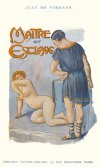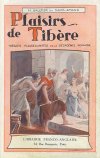Returning to Potsdam and Prussia in 1730, here are five separate stories I have come across while doing background research on Doris Ritter. Except for the first, they are only incidentally related to Doris's own story in that they happened by coincidence in that same year of 1730 in this quite small German residence town of Potsdam -- a startling concentration of gory public trials and punishments in a short period of time providing a colourful back drop to the sources directly concerned with the Prince's desertion and Doris's flogging. In any case, all five of these stories are on-topic for CF in general and in this thread. These are all quite lengthy, so I apologise for posting them in the original German without translation, but only posting a summary and selected quotes.
Three of these are from the
Mitteilungen des Vereins für die Geschichte Potsdams [Proceedings of the Society for the History of Potsdam], a club of local history enthusiasts founded in 1862 for monthly gatherings of discussions and presentations on a range of topics. These presentations were collected as essays in the proceedings published about every two years in the early period, thereafter more infrequently. Full scans of six of the first seven volumes published between 1864 and 1878 are available online at the Bavarian State Library website (
link), and a fascinating read they are, too, not least for the minutes of the meetings themselves with their everyday details of club luncheons and outings along with the learned debate. In retrospect, the essays are illuminating not only about the more-or-less ancient events they cover but also in that they reflect the morals and values of the time they were written -- the period of 1864 to 1878 was the very high point of Prussian nationalism with Bismarck's three consecutive victorious wars against Denmark (1864), Austria-Hungary (1867) and France (1870) leading to German unification under Prussia's lead in 1871, and the Prussian king becoming emperor of Germany, the end point of a historical arc that started with the successive reigns of Friedrich Wilhelm I and his son Friedrich II (The Great) in the 18th century. That made it tricky for the typical patriotic local worthy and hobby historian to be critical of those great hero kings of the past, even where they were fighting each other as during the Crown Prince's mutiny in 1730.
1) "Doris Ritter" by School Teacher Wagener (1868):
Of course, the fate of our tragic heroine Doris was an obvious topic for the local history society to cover, so my first essay I attach is their research into the source material at the local Town Hall archives. I won't say much about this as I have already posted all of the sources quoted in the essay (and more that were not known to the author), and Wagener's discussion is somewhat pedestrian and partly superseded by other sources which he didn't have access to. Still, this was the first ever serious acedemic paper on Doris Ritter (albeit by an amateur historian).
2) "The Last Use Of Torture In Potsdam" by Dr G. Sello (1876):
This essay concerns a different criminal trial and judicial punishment, but also with a young female subject, 26-year-old Anna Katharina Petsch, the unmarried daughter of a poor casual labourer, accused and convicted of killing her newborn baby. As the title of the essay indicates, she was the last one ever to be put to the torture in a criminal trial in Potsdam -- torture was abolished in Prussia in 1740 on the accession of Friedrich II. By coincidence, the protracted trial took place in 1729/30, and culminated with Anna's execution by drowning in the River Havel, stripped naked and sewn into a sack, on 25 April 1730 -- a mere four months before Doris was flogged in the same town. Drowning in a sack (sometimes with a live viper or cat, which is not mentioned here) derives from the ancient Roman punishment for parricide and was the standard pubishment at the time for women killing their own children, whether before the birth or (as here) afterwards. After the previous century's craze of witch trials ended, this was by far the most common crime for which women were executed in 18th century Germany.
Of Anna's guilt there was no doubt from the outset as she readily confessed to the killing at the time of her arrest, shortly after a baby's corpse was found outside the city walls on 6 June 1729. That makes it somewhat surprising that it took more than ten months until she was finally executed, after many interrogations and deliberations described in the essay. The reason for the delay, and for the use of torture (although not in the event actually performed -- she made the statement the judges wanted just as the hangman was about to tighten the thumb screws), was that she kept changing her story as to whether she was acting alone or whether the father of the baby (a soldier in the King's "Potsdam Giants" regiment with whom she had a previous baby that died at three weeks-old) told her to kill it. I won't go through the entire story, although it is a good read for German speakers, but there are a few parts of Sello's essay worth highlighting:
- Surprisingly to the modern reader (and probably also to the enlightened reader of the 1870s), Sello starts with a lengthy introduction praising the concept of judicial torture, which he says got a bad rap because of its association with the excesses of the witch trials and the inquisition. Applied "properly", it was -- Sello says -- the most fair and even-handed way of establishing guilt or innocence before the development of the modern criminal trial with cross examination and admission of forensic and circumstantial evidence. I have to say that Sello doesn't do his thesis any favours by recounting this particular case, where the authorities threatened Anna with torture until she finally relented and said she acted alone, thereby providing an excuse to let the soldier go free (although he did have to run the gauntlet) even though her earlier statement that he had coerced her into getting rid of the baby plainly has the ring of truth to it.
- Recounting Anna's relationship with her soldier lover, Grenadier Dempziger, gives Sello the opportunity to lament the poor state of sexual morals in Potsdam at the time, compared to the enlightened 1870s, with the virtue of the women and girls of Potsdam constantly under threat from the soldiery of the garrison and "hordes of loose women, prepared to commit any type of crime" were coming into town attracted by the presence of so many unmarried soldiers. At this point, our old friend Doris Ritter gets a mention in passing: "the sad example of Doris Ritter shows that even daughters from decent middle-class families were thought capable of similar loose conduct".
- When describing the mechanics of torture, we get a passage about the practice of stripping women naked for torture. Sello says that the law provided for women accused to be stripped for torture by respectable matrons and their nudity then covered with a cloth, but that in practice "tales of the greatest outrages committed by men" abound. Although Sello is too mealy-mouthed to say so, he plainly expects Anna to have been stripped by the hangman and paraded naked in front of the judge and magistrates. However, Sello is quite blasé about the sexual humiliation aspect of this, saying that women "in those distant times" were used to casual nudity and one shouldn't apply "the sensitivities of our time" [i.e. the 1870s]. I think he's plainly wrong here and that public nudity was very much a social taboo in the early 18th century -- various other sources say that even for men one of the most humiliating and dishonouring aspects of public flogging was that it was done on the bare, requiring at least partial stripping.
- Among the supporting cast of characters to the tale of Anna Petsch's trial and execution, we get several individuals who also make an appearance in Doris's story a few months later. The trial judge -- presiding at all interrogation and torture sessions -- is Mayor Klinte, to whom the King's order for Doris's flogging was addressed, and who desparately tried to save her from this shame, and Anna's confessor is Pastor Schubert (or Schubart), another one of the worthies who tried to convince the King at the last moment to spare Doris. Plus, of course, there is the King who had to confirm Anna's conviction and execution and the hangman of Potsdam himself, named as Hans Caspar List in this essay, who was responsible for conducting the Anna's interrogation and torture, and thereafter for carrying out her execution by drowning. Four months later, he would have been responsible for flogging Doris Ritter in accordance with the King's orders. We will learn much more about Herr List and his family in the next essay.
- Also relevant background for Doris's tale: during her ten months of incarceration, Anna was kept in the arrest cells "on the third floor of the Town Hall". That is where Doris was also kept from her arrest on 1 September 1730 until her flogging and dispatch to Spandau on 7 September.
- Finally, we get details of Anna's execution: after repeating her confession in public in front of the entire magistrate council, she was conducted by the town militia outside the city walls to a custom-built platform in the middle of the river, where she was stripped naked, put in a sack, drowned, pulled out after one hour, and buried in a shallow coffin -- the latter in accordance with her only repeated wish throughout her trial and detention, that she should be buried rather than left to rot on top of a wheel by the side of the road (the more common fate for executed delinquents at the time).
Enough for today -- three essays more to come in a follow-up post.





























 Do you know who the artist is of this picture? Simple, plain, and severe. Just how I like it.
Do you know who the artist is of this picture? Simple, plain, and severe. Just how I like it.![[Bruce Morgan] Artwork for Mia 9_1309427-0043.jpg [Bruce Morgan] Artwork for Mia 9_1309427-0043.jpg](https://www.cruxforums.com/xf/data/attachments/1060/1060641-75366a18cc97ce85ea5acfd0caca788e.jpg)










